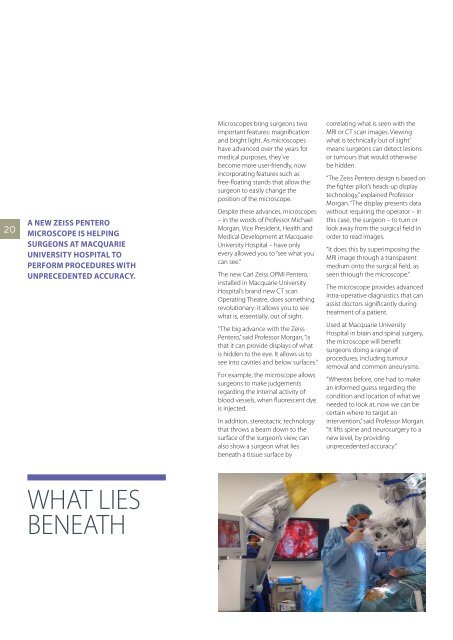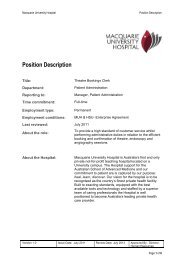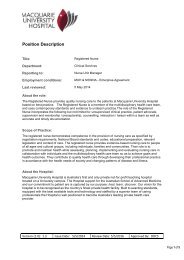reconstructive plastic surgery - Macquarie University Hospital
reconstructive plastic surgery - Macquarie University Hospital
reconstructive plastic surgery - Macquarie University Hospital
You also want an ePaper? Increase the reach of your titles
YUMPU automatically turns print PDFs into web optimized ePapers that Google loves.
20<br />
A nEw ZEiSS PEnTERO<br />
MiCROSCOPE iS HElPinG<br />
SuRGEOnS AT MACquARiE<br />
uniVERSiTY HOSPiTAl TO<br />
PERfORM PROCEDuRES wiTH<br />
unPRECEDEnTED ACCuRACY.<br />
WHAT lIeS<br />
BeNeATH<br />
Microscopes bring surgeons two<br />
important features: magnification<br />
and bright light. As microscopes<br />
have advanced over the years for<br />
medical purposes, they’ve<br />
become more user-friendly, now<br />
incorporating features such as<br />
free-floating stands that allow the<br />
surgeon to easily change the<br />
position of the microscope.<br />
Despite these advances, microscopes<br />
– in the words of Professor Michael<br />
Morgan, Vice President, Health and<br />
Medical Development at <strong>Macquarie</strong><br />
<strong>University</strong> <strong>Hospital</strong> – have only<br />
every allowed you to “see what you<br />
can see.”<br />
The new Carl Zeiss oPMI Pentero,<br />
installed in <strong>Macquarie</strong> <strong>University</strong><br />
<strong>Hospital</strong>’s brand new CT scan<br />
operating Theatre, does something<br />
revolutionary: it allows you to see<br />
what is, essentially, out of sight.<br />
“The big advance with the Zeiss<br />
Pentero,” said Professor Morgan, “is<br />
that it can provide displays of what<br />
is hidden to the eye. It allows us to<br />
see into cavities and below surfaces.”<br />
For example, the microscope allows<br />
surgeons to make judgements<br />
regarding the internal activity of<br />
blood vessels, when fluorescent dye<br />
is injected.<br />
In addition, stereotactic technology<br />
that throws a beam down to the<br />
surface of the surgeon’s view, can<br />
also show a surgeon what lies<br />
beneath a tissue surface by<br />
correlating what is seen with the<br />
MRI or CT scan images. Viewing<br />
what is technically ‘out of sight’<br />
means surgeons can detect lesions<br />
or tumours that would otherwise<br />
be hidden.<br />
“The Zeiss Pentero design is based on<br />
the fighter pilot’s heads-up display<br />
technology,” explained Professor<br />
Morgan. “The display presents data<br />
without requiring the operator – in<br />
this case, the surgeon – to turn or<br />
look away from the surgical field in<br />
order to read images.<br />
“It does this by superimposing the<br />
MRI image through a transparent<br />
medium onto the surgical field, as<br />
seen through the microscope.”<br />
The microscope provides advanced<br />
intra-operative diagnostics that can<br />
assist doctors significantly during<br />
treatment of a patient.<br />
Used at <strong>Macquarie</strong> <strong>University</strong><br />
<strong>Hospital</strong> in brain and spinal <strong>surgery</strong>,<br />
the microscope will benefit<br />
surgeons doing a range of<br />
procedures, including tumour<br />
removal and common aneurysms.<br />
“Whereas before, one had to make<br />
an informed guess regarding the<br />
condition and location of what we<br />
needed to look at, now we can be<br />
certain where to target an<br />
intervention,” said Professor Morgan.<br />
“It lifts spine and neuro<strong>surgery</strong> to a<br />
new level, by providing<br />
unprecedented accuracy.”

















